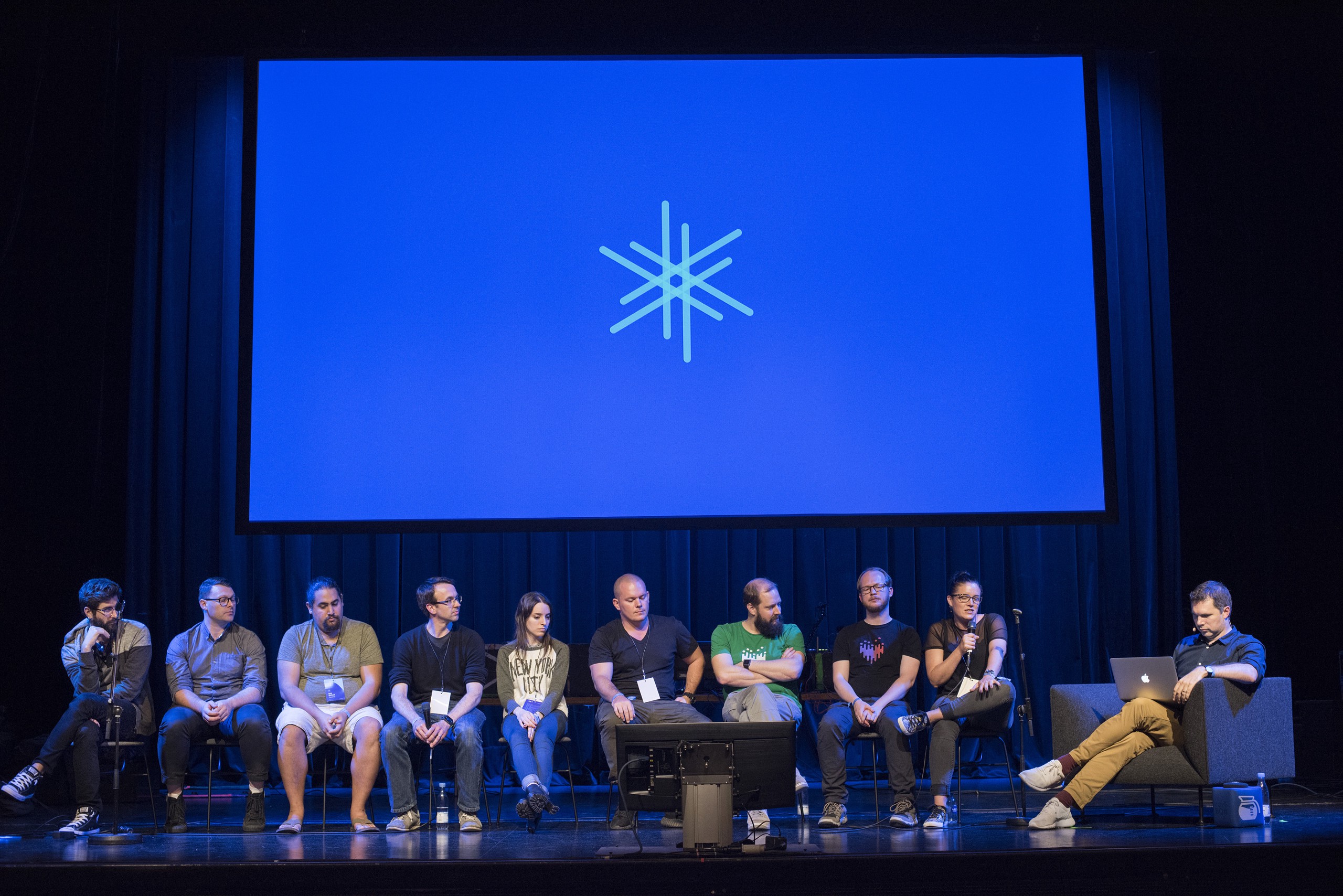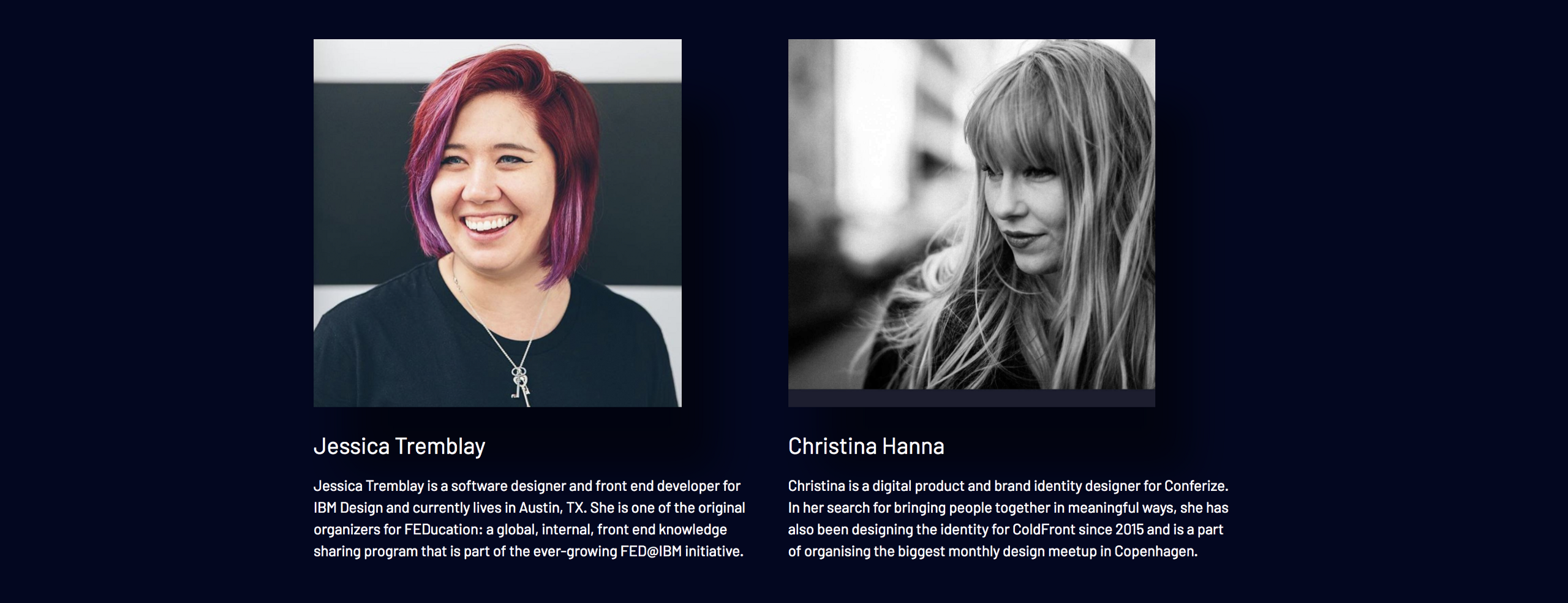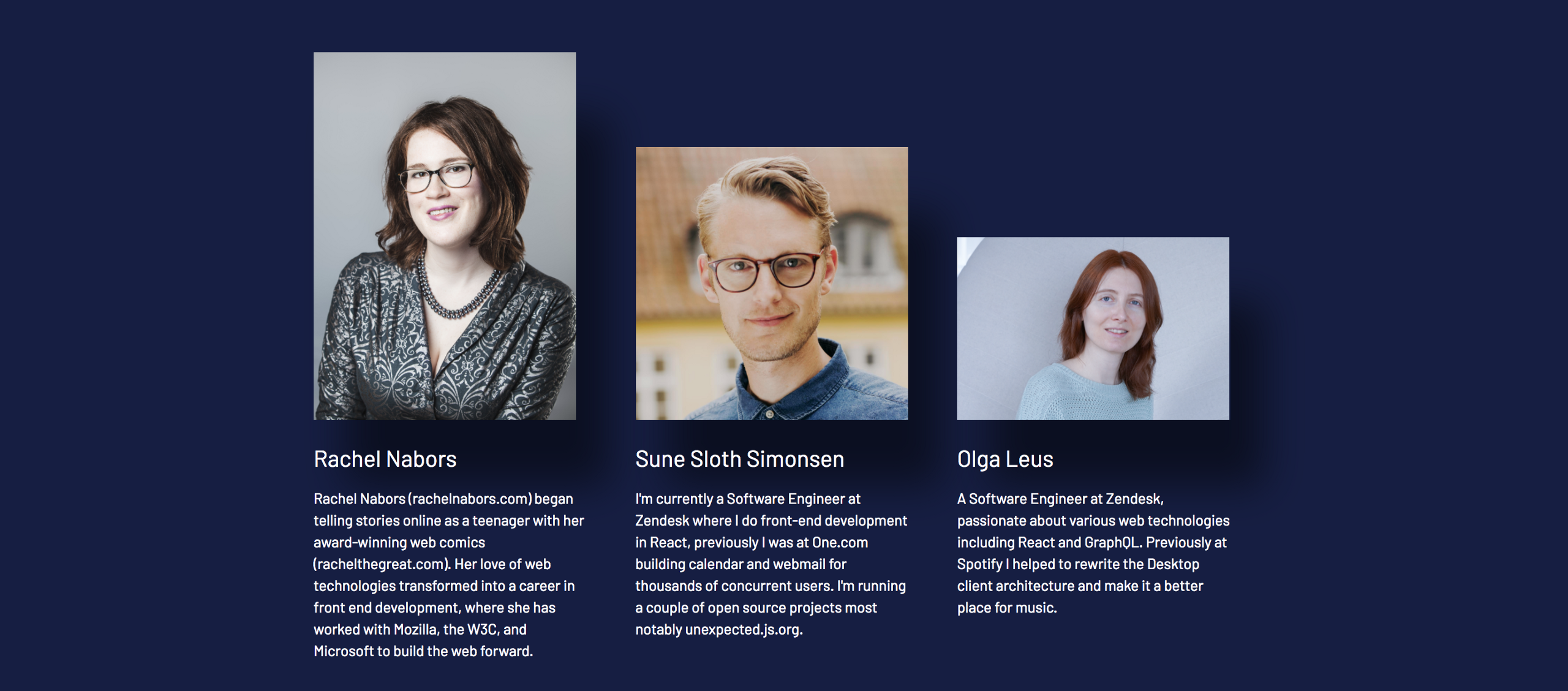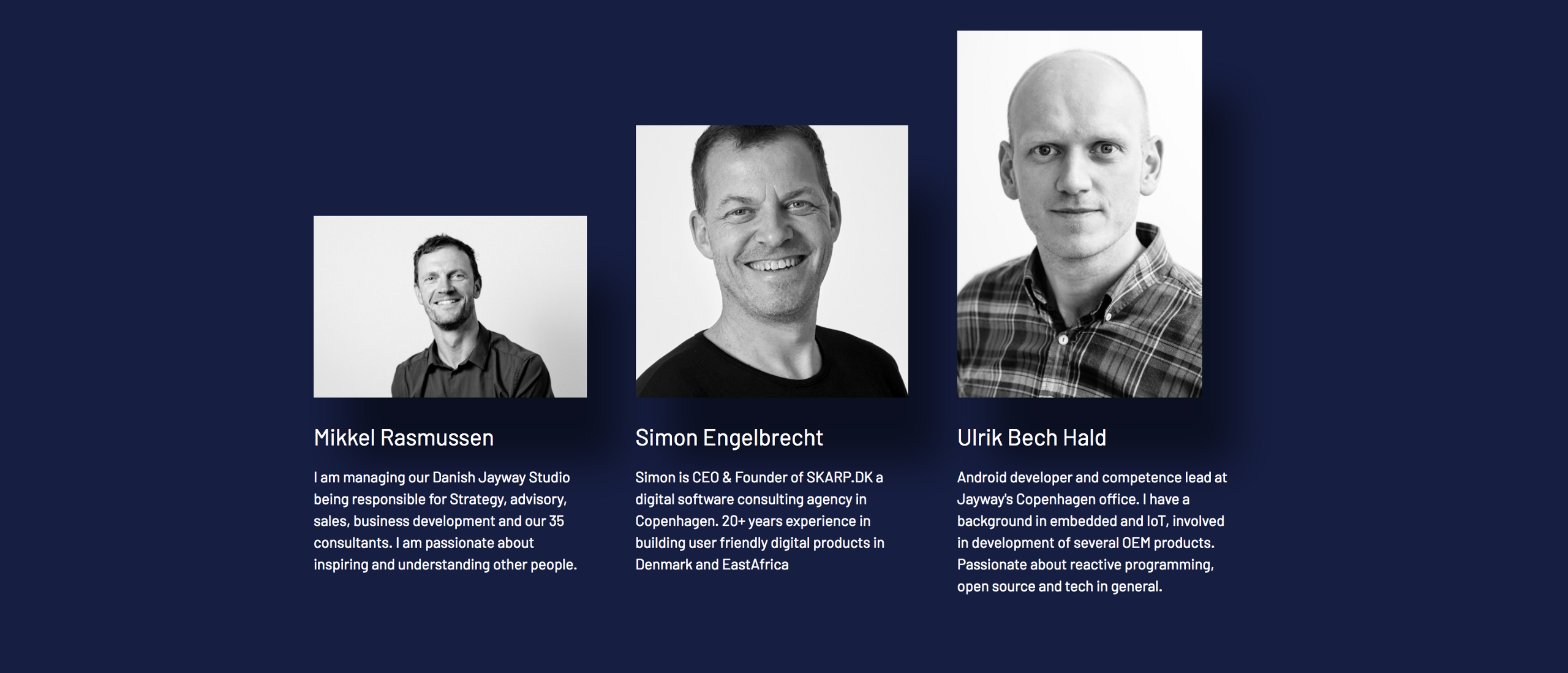
For the past 4 years I’ve been organizing a front-end conference in Copenhagen named ColdFront, and this year we are taking a holistic future outlook at the front-end landscape.
Let me tell you why.
ColdFront grew out of our monthly JavaScript meetup, CopenhagenJS to fill the need for bringing international speakers and inspiration to the city. You can say that the first ColdFront was a glorified meetup, where we rented a movie theater and filled it up until we couldn’t fit more people in.
Our focus back in 2014 was front-end as a discipline, which really meant a focus on the web platfrom, and the technologies related to the open web such as HTML, CSS and JavaScript. Over the years we have covered topics like
- New CSS standards and responsive Web Design
- Web frameworks like Ember.js and Reactive Programming,
- Web Performance, Offline First and P2P
- New browsers and web runtimes like Microsoft Edge, Samsung Internet, and Mozilla Servo,
- Service Workers, Progressive Web Apps
- Headless web, WebVR, IoT, Emerging markets.
- Native mobile platforms such as React Native
Most of these topics are centered around the open web platform, as the “front-end” role typically have been around building interfaces for the web. The web used to run only on our desktops, then mobile came along, and today the modern web is an application platform running everywhere, but the reality is that here in 2018, there’s more to the front-end discipline than just the web platform.
The front-end landscape and role has evolved
When looking at the front-end landscape it has never been as complex as it is today. The reality is that a modern front-end engineer needs know multiple platforms, technologies and each of their advantages and trade-offs, even before starting building the interface that is going to run on many platforms.
Below is a timeline showing the development of web technologies from 1999 to 2016, and reading posts like “How it feels to learn JavaScript in 2016” or Roadmap to becoming a web developer in 2018, makes us all feel the pain, but the reality is that here in 2018 the timeline has just continued to evolve at a even faster pace.
](/images/posts/1__h98__HcFJaFEuzdSA3ahFXw.png) Timeline from 1999 to 2016 by https://github.com/mraible/history-of-web-frameworks-timeline
Timeline from 1999 to 2016 by https://github.com/mraible/history-of-web-frameworks-timeline
In 2018 if you are building an interface that needs to run on all desktop, mobile and voice platforms in all markets around the world, you are forced to use multiple technologies that involves web, native and everything in between. Paul Kinlan from Google covered this new reality in his fantastic ColdFront talk about the headless web, and the raise of new meta-platforms back in 2015.
A few observations:
Big players betting on multiple front-end platforms
We are seeing big players like Facebook first shipping React for the web and now expanding React into a full front-end platform by enabling React to run every where with React Native and React VR. Google is betting multiple front-end platforms with Chrome for the web platform, Android for their own native mobile platforms, and Flutter as their multi-platform bet for Android and iOS. Even Microsoft has a skin in the game with cross-platform native apps powered by Xamarin.
MegaApps turning into front-end platforms
At the same time, and mainly outside of the western world we are seeing MegaApps such as WeChat turning into platforms with their own App Stores and application platforms, and yet we are seeing the open web striking back with the raise of The Progressive Web, and PWA’s as the response to the past many years of native dominating our mobile platforms.
We don’t talk enough about these new app platforms.
Voice and new interaction models are front-end too
Lastly we are seeing a whole new generation of front-end and interfaces raising powered by brand new interaction models such as Voice that has become the default interfaces for milions of users that have an Amazon Alexa or Google Home installed in their home.
Design and engineering are more integrated than ever
On the design front we are seeing design and engineering moving closer than ever before with the introduction of tools such as React, Sketch and Figma, that allows almost seamless hand-off and transitions between design and front-end teams, which has created an interesting vacuum and challenge for a both designers and engineers, as the role of those disciplines are being redefined as the worlds moves closer.
This is just a few of the areas where the front-end role is evolving, and to conclude and put it simple: The front-end role has evolved
Our front-end conferences are still focused around a religious set of technologies
So here in 2018 the front-end role is much more than just one platform or framework, and yet the reality is that most of out front-end conferences are still focused around an almost religious set of technologies that divides the front-end community into a fragmented set of micro-communities that each are preaching their religion and world-view.
I’m not pointing fingers to stay that there’s anything wrong with that, but I think it’s time to evolve our front-end conferences just like the front-end role has evolved to unify the many views, perspectives and experiences on what modern front-end development is.
Hello ColdFront 2018
This year marks the 5th anniversary for ColdFront, our front-end conference in Copenhagen. ColdFront has always been about the future of our industry, and this year we are expanding our reach by taking holistic view on front-end and interfaces that span’s across the web and technologies, to adopt ColdFront to the just described reality of the front-end role here in 2018.

By taking holistic view of front-end role we have invited an incredible crowd of international names to Copenhagen to cover this years perspective on“the future of front-end and interfaces”. We have asked each speaker to cover their theme and area in this perspective, and we are incredibly excited to create a melting-pot of technologies, perspectives, experiences and learnings from the full spectrum of the front-end landscape.
This year I’m also incredibility proud to make a few announcements on behalf of the ColdFront team on where we are headed with ColdFront:
A new bigger diverse international team located across multiple cities, in different 3 timezones, on 2 continents.
ColdFront started as a glorified community meet-up, and this year I’m proud to announce that we have expanded the ColdFront team, now spanning multiple cities in 3 different timezones on 2 continents. We have been joined by Jessica Tremblay from IBM, who runs the worldwide community FED@IBM program at IBM. We have Michael and Christina on the ground in Copenhagen, and myself in Seattle, US.
It’s an incredible team operating on taking ColdFront to new-levels!


Introducing two new collaboration partners of ColdFront
Over the years we have partnered with many companies in and around Copenhagen to bring a more diverse perspective to ColdFront, and this year we have partnered up with two great Copenhagen-based companies, Jayway and Zendesk to join ColdFront as our collaboration partners.
Jayway and Zendesk are big players in the Danish front-end scene, who over the many years have been supporting the community through meet-ups and conferences, and by being a part of ColdFront, they are helping us with resources, support and know-how for ColdFront.
Welcome Zendesk and Jayway!

Introducing the new Advisory Board for ColdFront
As our ambitions for ColdFront has grown over the years, we have also build a incredible network of leading voices in the front-end industry, and to make sure we are taking ColdFront in the right direction. I’m Incredibly proud to announce a new advisory board consisting truly world renowned and amazing people representing perspectives from the global front-end community.
We have leading voices from the international design community, the Node community, the Scandinavian agency scene, and big perspectives from Google and the W3C TAG covered, who’s all helping taking ColdFront to the next level through great advice and perspectives. Personally I’m beyond excited to have these awesome people as a part of ColdFront 😎



Introducing a 3rd ColdFront Community Day in collaboration with the Copenhagen front-end community
This year we are also expanding ColdFront with a 3rd day that we call our Community Day, which is all about connecting ColdFront further with the Copenhagen community, and to give our ColdFronters an opportunity to have something hands-on after two days full of inspiration.
We plan to host FREE workshops during the day for our attendees, and we are partnering up with the leading meetups in the Copenhagen front-end community, to create a melting pot of awesomeness 🎉
Many more details are to be revealed soon!
Much more to come 🎉
We are on to something big this year, and we are just getting started on announcing our speakers for this years conference, and I can’t wait to announce the incredible line-up of people who we haven’t had the opportunity to invite to Copenhagen before.
It’s gonna be a blast for ColdFront in November 🎉
And oh yeah, our Early Bird tickets are sold out.
If you want to be a part of ColdFront, don’t hesitate on contacting me or the team at hello@coldfront.co
/k